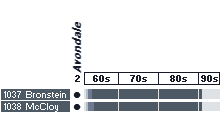

Length: 372' overall; 350' waterline.
Beam: 41'.
Draft: 23' including sonar dome.
Displacement: 2,650 long tons full load.
Propulsion machinery: 2 x 600 psi boilers; 1 geared turbine, 20,000 shp; 1 shaft.
Design speed: 26 knots.
Design complement: 13 officers; 178 enlisted.

Authorized in FY 1960, the Bronsteins were laid down at New Orleans’ Avondale Shipyards in 1961, launched in 1962, commissioned in 1963 as DEs 1037 and 1038, redesignated frigates (FF) in 1975, decommissioned in 1990, stricken in 1991 and sold to Mexico in 1993. While they carried over the Dealeys’ 600 psi engineering plant, their new hull form—visually much different with a sharply raked bow (to provide clearance for the bow anchor to drop without hitting the sonar dome) and an extended forecastle but imperceptible sheer—made them faster. Nearly comparable in length and tonnage to late-World War II destroyers, they still developed only 1/3 as much horsepower, however, leaving them too slow to operate with contemporary task forces. The added topweight and sonar made them bow-heavy and extremely lively. Accordingly, they were not repeated: follow-on production appeared as the larger, faster and more stable Garcia class.
Sources: Bauer & Roberts, Friedman, Silverstone.